The Best Ways to Stop Kids from Binge Drinking

Training bartenders and banning two-for-one sales can help limit underage drinking in high school and college students.
Underage drinking is scary.
If we define a binge as downing five or more alcoholic drinks at a time, it’s common on campus — nearly 40 percent of college students confess they’ve done it in the past month. The problem is actually a bit smaller than it was 35 years ago. You don’t want your child falling into this pattern: too many binge drinkers get worse grades, end up with rap-sheets, commit booze-fuelled rape, and die behind the wheel.
According to studies cited by the National Institute on Alcohol Abuse and Alcoholism (NIAAA), alcohol is tied to more than 1,800 student deaths each year; almost 700,000 suffer injuries. Lots of people confess that they’ve been too drunk to even know if they consented to sex. About a quarter of students say their drinking affects their academic performance.
RELATED TOPIC: Alcohol Does More Harm than Heroin and Crack
To help colleges and states tackle the problem, the NIAAA has created a website that ranks the effectiveness of a variety of possible solutions.
At the top of the list:
- Keep the legal drinking age at 21. Research has backed up the policy, linking it to preventing an estimated 900 deaths among young drivers, and reducing alcoholism and suicides.
- Restrict happy-hours and price cuts.
- Keep Sunday bans. There’s evidence they do reduce overdrinking.
- Restrictions on hours of sales also help, some data shows.
- Enforce the drinking age and promote compliance. One approach: Recruit 21-year olds to work as undercover agents and give store clerks who asked for ID a congratulatory letter and gift certificate “reward” — and a “reminder” if they failed. The next step: send in underage buyers and punish stores and clerks that sell them alcohol. Data from an Oregon statewide “compliance check” program found that the percentage of cases of sales to minors dropped from 28 percent to 17 percent during a 4-year study.
- Alcohol taxes do seem to reduce heavy drinking; one study estimated that an extra 25 cent tax per drink would cut heavy drinking by 11 percent.
- Require that servers, managers, and bar owners complete formal training on signs of drunkenness and what to do.
Other policies you’d think would help have had mixed results, or haven’t been studied thoroughly. These include banning alcohol at campus social events, requiring that students take Friday morning classes, creating alcohol-free dorms, running “party patrols,” and banning home delivery.
One-on-one education can also work. For example, one small study tested the effect of a guided-meditation practice an hour a week for a month. Meditators had 2.6 fewer binges on average than a control group. They didn’t plan on giving up drinking, but they weren’t as likely to go overboard, presumably because they had developed more awareness of their actions.
The NIAAA list of successful interventions includes “cognitive behavioral” or CBT programs targeted at problem drinkers. These provide the facts about addiction and train students over several group meetings to identify their drinking triggers and practice turning down drinks.
One research-backed technique doesn’t require any meetings. Students get emails with a chart and text comparing their self-reported drinking to their peers. Evidently, some kids don’t realize that other students drink much less. A third way to create awareness: ask students to fill out an online questionnaire about their drinking, then actually monitor their drinking for two weeks and meet with a counsellor to discuss their scores. One way or another, the hope is that seeing the facts while sober is, well, sobering.
Updated:
April 02, 2020
Reviewed By:
Christopher Nystuen, MD, MBA